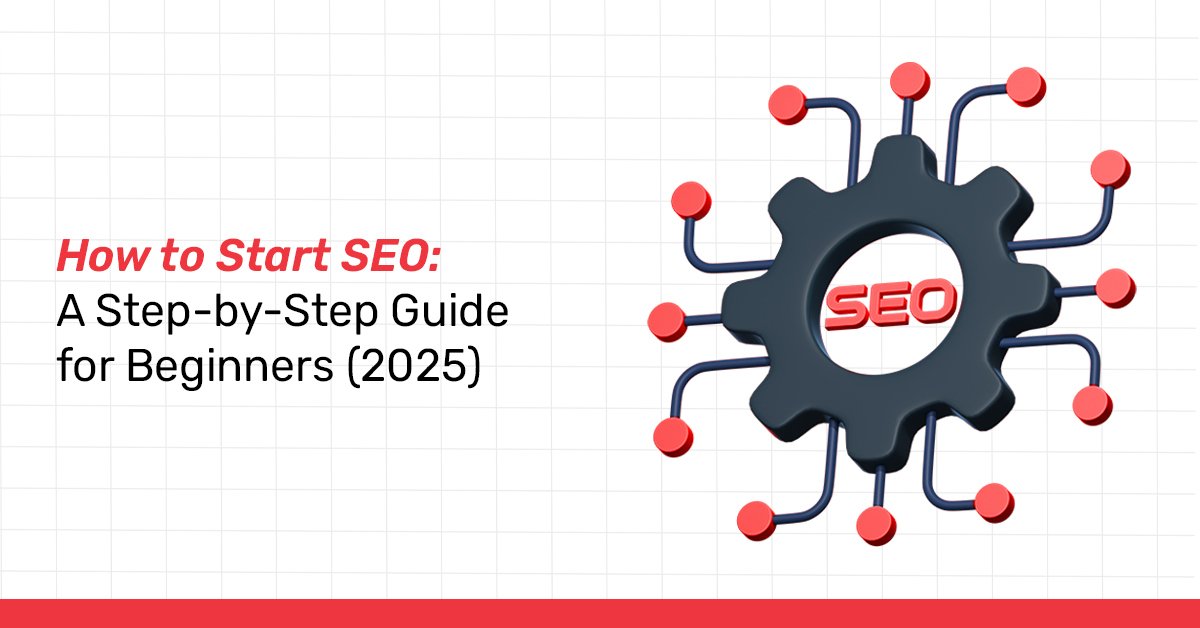SEO (Search Engine Optimization ) is one of the most effective tools or methods to improve website traffic and ultimately revenue in today’s online world. While SEO may seem difficult to novice users in 2025, with the application of updated search algorithms, constantly changing best practices, and definitions of quality and user experience standards, this comprehensive yet easy-to-read guide will simplify this process and allow new users to create an efficient and future-oriented starting point for their website.
Why Is SEO Important and What Is SEO?
- SEO encompasses all the techniques that help search engines find, index, and rank web content so it appears for relevant searches and generates ‘organic’ (unpaid) visitors.
- With over 8.5 billion Google searches daily, being able to find yourself at the top of the results could be the difference between expanding into a new market and being completely visible online.
SEO is vital for anyone who wants to:
- Have a reliable, continuous flow of visitors.
- Connect to new audiences without paying for every click.
- Develop authority and reliability in your industry, and help you to become the most trusted design agency in Gurugram.
- Excel beyond competition online.
Step 1: Get to Know the Fundamentals of SEO
- A good SEO strategy consists of four basic principles that must be used together. Your site needs to load fast for technical SEO.
- Content and HTML on-page SEO play a part in getting the right keywords and phrases into your website. Content SEO is all about creating excellent resources for your site’s visitors.
- For example, off-page SEO also includes brand mentions and backlinks to help increase brand trust.
Staying Relevant in 2025
SEO is constantly changing. By 2025, Google’s algorithm will be smarter than ever, pointing out these views:
- Relevance and quality are more valuable than keyword stuffing.
- Experience: The writer has experience or first-hand expertise.
- Metrics of actual user experience and engagement (i.e., time on page and bounce rate).
- Secure (HTTPS), mobile-friendly, fast websites.
- Submit an XML sitemap to Google Search Console.
- You can achieve real E-E-A-T (Experience, Expertise, Authoritativeness, Trustworthiness).
Step 2: Define Technical Principles for a Powerful Website
Title: Importance of Technical SEO
Introduction: Strong technical SEO is essential for website performance.
Key Points:
• Ensure key pages are accessible; check robots.txt.
• Employ the use of canonical tags to resolve duplicate content issues.
• Design mobile-first because of the high volume of mobile visits.
- The takeaway: Good technical SEO sets the foundation for site accessibility and performance, adding to the new achievements in the performance marketing agency in Gurugram.
Site Performance and Valuable Web Metrics
HTTPS Security
Implement an SSL certificate (HTTPS) to protect user data-this improves your rankings and demonstrates trustworthiness and reliability to your users.
Organized Data & Schema Markup
Schema helps search engines understand your data better and improves search engine results with enhanced outputs such as product review stars or frequently asked questions. For example, you can check the previous projects of the design agency.
Step 3: Conduct Smart Keyword Research
Keyword research is the process of discovering the exact words and phrases your audience uses in search engines. Using the right target keywords increases desktop and mobile visibility for your content. For example, you can use keywords for a design agency like the affordable design agency in Gurugram.
How to Start
Pinpoint high-profile issues from around your business or audience. Look for keywords and their search data with tools like Google Keyword Planner or Semrush. If nothing else works, use longer, more descriptive search terms ; they will give you less relevant but also less cluttered results.
Look at Competitors
Examine the topics that top competitors write about. Tools like SEMrush and Ahrefs will show you their top keywords and the content gaps that you can cover and improve.
Focus on User Search Intent
Informational (how to, what is, tips for…)
Transactional (buy, order, worksheet, cost)
Directional (exact brand or product name)
Ensure that the main keyword phrases on each page match the audience’s needs for that page.
Step 4: On-page Search Engine Optimization
– Improve Each Element
- On-page SEO is the process of improving the quality, clarity, and keyword optimization of web pages for users and search engine bots.
- Title Tags
- Place the main keyword as far to the front as you can.
- The titles should be less than 60 characters to keep a full SERP line.
Meta Descriptions
- Shorten the content to 155 characters or fewer and include your keyword.
- Encourage users to click by offering a reward or challenge.
URL Format
- Use short, easy-to-read URLs and relevant keywords. Example: /seo-guide-2025/
- Ensure to avoid digits, specifics, and unnecessary language.
Tags:
- Every page must have only one H1 (main heading) that contains relevant keywords.
- Use H2 and H3 for headings to maintain logical structure.
- Visual Search Engine Optimization
- Use thorough filenames (e.g., seo-plan-2025.png).
- Use descriptive alt text for the photo to sustain accessibility and optimize for search engines.
Linking Internally
- Link to other relevant pages on your site with descriptive link text.
- This helps users navigate and spreads SEO “juice” around your site.
Step 5: Create Useful, Great-Quality Content
Content is still king in the world of SEO. In 2025, it is not just about creating a large amount of content but about providing true value and establishing yourself as an authority.
What Determines Content Rankings?
- Creativity: Offer a new perspective or question to answer. Avoid duplication of information.
- Richness: Provide comprehensive coverage of the topic, addressing all potential questions from users.
- Engagement: Create content utilizing formatting, visuals, video, bulleted lists, and descriptions to keep users interested in the content.
- Novelty: Regularly update all of your content; outdated content lowers rankings.
- Length for Content:
For basic content or long-form guides, you should target 1,500-2,500 words. Listicles and short answers probably won’t be as long; however, length will usually yield better results for long-form articles.
Step 6:
- Try to stick with E-E-A-T (Experience, Expertise, Authoritativeness, Trustworthiness).
- Google rewards sites that describe:
- Experience: The writer has experience or first-hand expertise.
- Informed: Writing demonstrates knowledge and experience, though it may lack evidence of critical thought. Containers are a form of wrapping that demonstrates competency over the art being covered.
- Authoritative: The target audience considers the site and/or author to be an authority on the subject.
- Reliable: The audience should be able to rely on the information and content as being accurate; contact information and links to authoritative sources are other considerations that may be included.
Step 7: Off-Page SEO-Uphold Reliability Through Backlinks
On-page SEO controls everything that happens on your site; off-page SEO looks at how you’re gaining attention from the entire web.
What are Backlinks?
- A backlink is a link from another website to yours. Good backlinks:
- Act as “a vote of confidence” for you.
- Generate referral traffic.
- Provide your site with reliability to help with ranking.
How to Build Links
Guest post on established blogs in your niche.
- Be dynamic: perform resource searches, then request to be added to the lists of suggested resources.
- Leverage whatever expertise you have in podcasts, webinars, or forums, and use them to gain links and excitement.
- Be cautious; do not use any spammy techniques like buying links-it will harm your ranking in Google.
Step 8: Manage, Measure, and Improve
- SEO is never a one-off activity. You will need to constantly track how your campaign is performing and adjust based on that data.
- Use Analytics Tools to Measure:
- Google Analytics: Track site activity, including traffic, bounce rates, and how users navigate through it.
- Google Search Console: Track rankings, impressions, clicks, and performance issues.
What are you monitoring?
- You should see more organic traffic.
- SEO rankings for keywords related to specific queries.
- Click-Through Rates (CTR) that appear in search engines.
- Conversions: Are visitors doing what you want them to do (registering, purchasing)?
Continuous Updates
- Update old posts or analyses with new statistics or viewpoints.
- Remove or edit poorly performing pages.
- Add new content for new keywords or gaps identified by competitive analysis.
Step 9: Be Proactive in SEO (2025 and Beyond)
Algorithms and user behavior will continue to change, requiring you to adapt your strategy. Follow credible sources for updates. Pay attention to voice search, AI search changes, and visual search. Focus on user experience with load speed, mobile design, navigation, and authenticity.
A Practical Example: A Simple SEO Strategy
Assume you decide to create a new site for your local bakery. Here is how to start an SEO strategy:
- Technical Search Engine Optimization: Ensure that your site has fast load speeds (through image optimization, good hosting) and is mobile-responsive.
- Keyword research: Always remember, the keywords you target for local audiences should differ from informational keywords and vice versa when conducting your keyword research, such as for a design and development agency.
- On-page SEO: Optimize your title, meta description, and headings for these keywords on each page. Include high-quality, labeled, varied images.
- Content Strategy
- Off-page SEO
- Monitoring: Set up Google Analytics, check what pages rank from top to bottom, and continue writing about the subjects attracting qualified visitors.
Common Mistakes
Avoid keyword stuffing, as you can be penalized and it will create unreadable content. Confirm that your website is mobile-friendly, loads quickly, and has no technical SEO issues. Provide original content and fulfill user needs for real value. Instead, you can highlight the agency name for which you are working, like FRD Studio.
Suggested SEO Tools for Beginners
- Keyword Research: Use tools like Google Keyword Planner, Ubersuggest, Ahrefs, and SEMrush for easy audience outreach.
- Technical Audits: You can use tools like Google Search Console and Screaming Frog.
- Content Improvement: Enhance your content by using Yoast SEO, SurferSEO, and Clearscope.
- Analytics: Google Analytics and Google Search Console are preferable for achieving better results.
- Writing and Editing Tools: Visit tools like Grammarly, Hemingway, and Word Counter to help you improve.
Summary:
Start doing SEO in 2025. It’s easy to focus on technical optimization, keyword research, better quality content, and purposeful outreach. But core principles like user service, authority, and quality writing still matter. Refine (and update often) your strategy. Your SEO strategy should be regularly updated every few months to keep in line with evolving search engines and user preferences.












